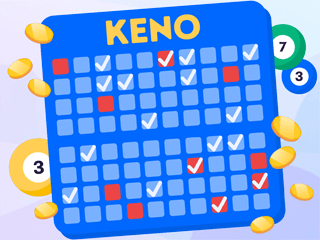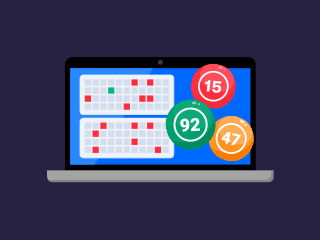Keno odds and payouts explained
Keno is a game of chance, no doubt about it. But trust me, understanding the odds and payouts can give you a serious edge. In this guide, I’m breaking down everything you need to know — odds, payouts, and how to calculate them — so you can approach Keno with more strategy and less guesswork.
How Keno works
Keno is simple at its core — you pick spots (numbers) from a pool of 1 to 80, and then a random number generator (RNG) draws 20 numbers. The goal is to match as many of your picks (called catches) as possible with the drawn numbers. The more numbers you match, the bigger your payout.
The mechanics are the same across most Keno games, but odds and payouts can vary depending on the casino and the specific variant you’re playing. Here’s how it goes:
- You select your spot from 1 to 80.
- A random draw picks 20 numbers.
- If your picks match the drawn numbers, you win. How much you win depends on how many of your spots match and the bet you placed.
Now, about that RNG. It’s what keeps Keno fair and square. The RNG ensures every draw is random and independent, meaning no past results affect future outcomes. Each number has the same shot of being drawn, regardless of how often it’s been selected before.
The RNG is tested and certified by regulatory bodies to guarantee fairness, so while you can study the odds and apply strategy, remember that luck still plays a big role.
Key Keno terms
Before we dive into the numbers, let’s quickly go over some key Keno terms you’ll encounter throughout this guide:
How Keno payouts work
Keno payouts are based on how many of your selected spots match the 20 numbers drawn. The more catches you get, the bigger your payout. But here’s the thing: the more spots you pick, the harder it gets to match them all.
Here’s how it breaks down:
- 1-spot. Match just one number, and the payout’s smaller, but it’s the easiest one to hit. You’ll likely see this one more often, making it a good option for keeping your bankroll steady.
- 2-spots. Match two numbers, and the payout increases, but the chances of hitting both go down.
- 5-spots. Matching all five numbers is challenging, but the payout is much sweeter if you do.
- 10-spots. The payout for hitting all 10 numbers is huge, but let’s face it—it’s extremely rare to hit all 10.
Here’s the big takeaway: fewer spots = better odds, but more spots = bigger payouts.
That said, while the payout structure tends to follow a similar pattern, remember that casino-specific paytables can vary. Regional regulations and specific Keno variants could affect payouts. Always make sure you check the paytable before you start playing to understand exactly what you’re working with.
Lastly, if you’re betting more than $1, the payouts usually increase proportionally. For example, if you wager $5 on a 5-spot game where the payout for matching all five numbers is $500, your payout would rise to $2,500. However, be careful — higher wagers don’t always scale exactly, and some casinos may have different rules. Always double-check how an increased wager affects your payout potential.
Keno payouts chart
Now, let’s check out this detailed payout chart for a standard 80-number, 20-draw Keno game, using $1 as the base bet. While this chart reflects general industry averages, keep in mind that actual payouts can vary depending on the casino’s paytable.
| Number of Spots | Payout for 1 catch | Payout for 2 catches | Payout for 3 catches | Payout for 4 catches | Payout for 5 catches | x to 1 |
|---|---|---|---|---|---|---|
| 1 | $3 | N/A | N/A | N/A | N/A | 3 to 1 |
| 2 | $10 | $50 | N/A | N/A | N/A | 5 to 1 |
| 3 | $50 | $150 | $500 | N/A | N/A | 15 to 1 |
| 4 | $100 | $300 | $1,000 | $5,000 | N/A | 25 to 1 |
| 5 | $500 | $1,500 | $5,000 | $25,000 | $100,000 | 50 to 1 |
| 6 | $1,000 | $3,000 | $10,000 | $50,000 | $200,000 | 100 to 1 |
Note: These payouts are approximate examples.
How to calculate Keno odds
Keno odds might seem tricky at first, but once you break them down, they’re all about basic math.
Example 1: 1-spot game
Formula: (Total possible combinations) / (Total combinations for your selection) = Odds of winning
With 80 numbers in the game, your chances of matching that single selected number are 1 in 4. So, it’s a lot easier to hit that one number, but your payout will be smaller since the odds are better.
Example 2: 6-spot game
Formula: 80 choose 6 (combinations of 6 numbers from 80) = 1 in 7.1 million
In this case, your odds of matching all 6 numbers you pick are incredibly slim. You’re going for a higher payout, even though it’s harder to hit. Understanding this helps you decide how much risk you’re willing to take on for that big win.
Keno odds chart
Here’s a breakdown of the odds for matching the number of spots you select in a standard 80-number, 20-draw Keno game:
| Number of spots | Odds of winning |
|---|---|
| 1 | 1 in 4 |
| 2 | 1 in 24 |
| 3 | 1 in 133 |
| 4 | 1 in 1,000 |
| 5 | 1 in 8,000 |
| 6 | 1 in 50,000 |
| 7 | 1 in 300,000 |
| 8 | 1 in 2.5 million |
| 9 | 1 in 25 million |
| 10 | 1 in 230 million |
Tip: The odds of winning improve as you choose fewer spots. But, remember, fewer spots mean smaller payouts — so it’s all about balancing risk with reward.
Advanced Keno odds calculations
For players who want to dive deeper into the statistics behind Keno, let’s explore how combinations and permutations work. The odds of hitting specific spots can be calculated using combinatorics, which is all about counting combinations and arrangements.
Combinations (choosing numbers)
When you pick spots in Keno, you’re essentially choosing a subset of numbers from a larger pool (for example, selecting 6 numbers from 80). To calculate the total number of possible combinations for a given number of spots, we use the combination formula:
Formula:
nCr = n! / r!(n – r)!
Where:
- n is the total number of options (in Keno, that’s 80 numbers),
- r is the number of spots you select.
This formula helps you calculate how many possible ways your selected numbers could appear. It’s the math behind the odds.
Example: 6-spot game
Let’s apply the formula to a 6-spot game. The calculation looks like this:
80C6 = 80! / 6!(80 – 6)!
This results in odds of 1 in 7.1 million for hitting all six numbers.
While it may seem like a complex formula, it’s a useful way for players to understand the math behind selecting their spots and how to calculate their odds. Now, you can see why the more numbers you choose, the tougher it is to win, but the bigger the payout potential!
Odds for special Keno variants
If you’re looking to shake things up, special Keno variants are where the excitement really kicks in. Each one has its own unique odds and payout structure. Here’s a quick guide to some of the most popular ones:
🎱1. Packaged Keno
Packaged Keno lets you bundle multiple bets into one neat package. The odds vary depending on your mix, giving you more flexibility to create your ideal betting strategy.
For example, if you mix a 1-spot and a 2-spot bet, your overall odds will be a combination of those individual bets’ odds. This increases the number of potential ways to win, but the risk also increases. If you are betting on more combinations, you get more opportunities to win, but the odds of winning on each individual combination decrease. Think of it as layering your bets—more chances but slightly worse odds for each individual pick.
In standard Keno, the odds of hitting a single number (1-spot) are 1 in 4, and the odds for hitting a 2-spot are 1 in 24. In Packaged Keno, while you are multiplying your chances, keep in mind that each combination has its own set of odds that are less favorable than when betting fewer spots.
🎱2. Caveman Keno
In Caveman Keno, you pick numbers in groups — usually 5 or 10 at a time. It slightly improves your odds of hitting big, but don’t get too carried away. It’s still a tough game to crack, and hitting those big numbers isn’t guaranteed.
- With 5 numbers, the odds of hitting all 5 are about 1 in 6,000.
- With 10 numbers, the odds of hitting all 10 drops significantly to 1 in 2.3 million.
The improvement in odds comes from the fact that you are selecting more numbers, but with a larger pool, your chances of hitting all of them are still extremely slim. The more numbers you pick, the greater your payout potential, but your chances of winning drop with the increasing spots.
🎱3. Club Keno
Club Keno adds a bit more flavor to the mix. Your payout can change based on your club membership level. The more you play, the better your odds and rewards. If you’re a regular at the casino, check out how your membership perks can boost your chances.
However, the odds themselves are essentially the same as regular Keno.
For example, in regular Keno, the odds of hitting 3 spots is about 1 in 133, while 4 spots have odds of 1 in 1,000. In Club Keno, the odds do not change significantly, but if you have a higher membership level, you may receive bonuses like multipliers on winnings.
Even with membership perks, the base odds of winning remain as follows:
- 1 spot: 1 in 4
- 2 spots: 1 in 24
- 5 spots: 1 in 8,000
🎱4. Cleopatra Keno
In Cleopatra Keno, the game adds bonus rounds and multipliers, which increase your payout potential but don’t affect your base odds. The odds for hitting 1 spot (1 in 4) or 5 spots (1 in 8,000) stay the same as regular Keno, but when you hit bonus rounds, multipliers can multiply your winnings significantly.
For example, the multiplier could range from 2x to 5x depending on the game, so hitting all your numbers could pay out up to 5 times more than regular Keno. However, the odds of hitting a bonus round are not guaranteed, so while the payouts are larger, the base odds for hitting specific numbers don’t change.
🎱5. Power/Super Keno
Now we’re talking real power. Power and Super Keno offer multipliers for hitting certain numbers, which increases the payout potential. While the odds of winning a single number in regular Keno are 1 in 4, the payout for hitting certain numbers is increased through multipliers.
For example, if you hit a 5-spot (1 in 8,000) in Power Keno, your payout could be increased by up to 10x, turning a standard $500 payout into $5,000. However, your base odds don’t change—the odds of matching all five numbers remain incredibly low. These variants offer great potential for larger payouts, but the odds of winning the larger prizes are still extremely low.
🎱6. Way/Combination Keno
In Way/Combination Keno, the concept is simple — you mix multiple bets into one. This increases the number of possible outcomes and your chances for smaller, more frequent wins. However, your odds of hitting a large jackpot are diminished since the bet is split into smaller sections.
- For 2-way bets, your odds of winning increase to 1 in 12, but your payout is much smaller than hitting a 5-spot jackpot.
- For 3-way or 4-way bets, you increase your chances of winning smaller prizes, but the payout will be lower.
This variant is great for players who prefer consistent smaller wins over trying to hit big jackpots. As a result, your chances of winning increase significantly, but the payout potential for each bet is reduced.
Common misconceptions in Keno
There’s no shortage of myths floating around Keno — especially when it comes to “lucky” or “hot” numbers. Let me set the record straight:
- Keno is a game of chance
First and foremost, Keno is all about chance. There are no secret patterns or foolproof strategies that guarantee success. Every draw is independent, and the RNG ensures that the game is completely random. This means past results have zero impact on the current game — it’s all about luck, plain and simple. - Hot and cold numbers
Some players swear by “hot” or “cold” numbers — numbers that seem to pop up more often or ones that haven’t shown up in a while. But here’s the truth: it’s all superstition. The odds for each number are the same every time, regardless of how many times they’ve been drawn before.
Maximizing your odds in Keno
While Keno is primarily a game of chance, understanding how to work with the odds can definitely give you an edge. Here’s how I approach the game to maximize my chances:

Stick to 4-8 numbers
Based on my experience, playing 4-8 numbers is where I find the best balance between odds and payout. Too few, and the payouts are smaller. Too many, and hitting all your numbers becomes a real long shot. This sweet spot offers solid odds and keeps the game interesting without overloading your bet.

Always check the paytable
Before jumping into a game, I always take a moment to check the paytable. Some casinos offer bonus multipliers or unique game variations that can tweak your odds or payouts.

Skip the "Lucky Patterns"
Look, I get it—there’s a temptation to go after “hot” numbers or patterns. But here’s the deal: the RNG ensures that every number has an equal shot at being drawn. The numbers you pick don’t hold any special power. So, ditch the superstition and focus on playing the odds.

Online vs. Live Keno
I personally enjoy online Keno for its speed—everything’s quicker, and the RNG keeps things fair. Live Keno, though, has a slower pace and gives you that physical casino vibe with the added human touch. Both versions use the same odds, but I find that my playing style adapts to the pace, so choose what suits you best.
FAQs
What Keno game has the best odds?
Power Keno and Club Keno are my go-to picks for better odds. The added multipliers and combination bets increase your chances of winning, making these versions a smart choice if you’re looking to boost your odds.
How do you calculate Keno odds?
It’s actually pretty simple: Keno odds are calculated by dividing the total number of possible combinations by the number of combinations you’ve selected. This gives you your chance of winning based on the spots you pick.
What are the odds of winning Keno?
The odds really depend on how many spots you select. Fewer spots mean better odds of winning, but your payout will be smaller. More spots increase the payout potential, but the odds of hitting all your numbers go way down.



